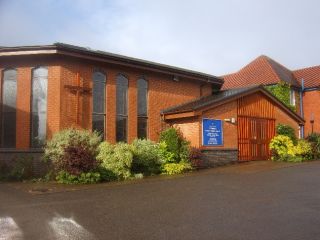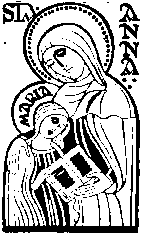|
| |||||||||||||||||
| |||||||||||||||||
|

SOME HISTORY... The begining... The parish of St Anne, Chapel End, Nuneaton began its life just after the second world war. The western side of Nuneaton was – in common with the wider area – greatly shaped by quarrying and mining. At that time, all of Nuneaton was part of the parish of Our Lady of the Angels, in the town centre. In the mid-1930s Mass was being said by priests from that church in a house in Tunnel Road, Galley Common, a mining community at that time. Ten years later, they were saying Mass in the Green Lane Miners’ Hostel, Camp Hill, just off Camp Hill Road. In about 1946 the Hostel became unavailable, and the congregation was offered the use of an abandoned isolation hospital off Windmill Road. This was far from ideal, and so, after much planning and fundraising (bricks were sold at 1d each, for example) the foundation stone of the first St Anne’s Church was laid on 19th February 1949 by Fr Cox, parish priest of Our Lady of the Angels. On 13th July of the same year Archbishop Masterson blessed and opened the building. At about this time, the arrival of workers from Scotland, the north of England, and eastern and central Europe was at its height. Some brought with them their families, and the younger unmarried began to marry and have children. The story of one man, the late Ivan Novak from Croatia, caught up in the turmoil of the war's end, who came to Nuneaton and joined the parish in its early days may be read here on the BBC website. Camp Hill, a very large housing development built by the National Coal Board and now an area undergoing massive regeneration, was constructed in the 1950s and 60s. Hartshill and Ansley Common nearby grew too. In response to this growth St Anne's became a parish of its own in 1952 and Fr Patrick Meagher came as priest in charge. Soon afterwards, St Joseph’s Church, New Arley came into the parish.
Mrs Barbera Beauchamp, a long standing member of the parish, has written about some of the early history of St Anne's from her own recollections. We are fortunate to have her account. She writes -
Arley had been part of the parish of Bedworth, and in the 1920s Canon Wall began to say Mass in various houses in the village. By the mid-1920s, coal mining was attracting an influx of workers to Arley (many from the north of England) and the village grew. A site was acquired and, with the help and support of the community, a wooden church was built and in the summer of 1926 a procession from Arley Cricket ground to St Joseph’s marked the opening of the new church. By 1928, a congregation of two dozen was normal. During the height of the Second World War, the church was used less and parishioners attended Mass at Nuneaton or Bedworth. After the war, things picked up and a succession of curates from Nuneaton and Bedworth took care of the Catholic community. At that time, St Joseph’s had a hall which became a centre of social activity. In 1959, responsibility for St Joseph’s and the surrounding area was transferred from the parish of Bedworth to the parish of St Anne, Chapel End. Over the years, this parish with its two churches expanded, the parish school was founded and a worshipping community was cared for by a succession of parish priests. The last years of the 20th century... When Fr Michael Stack arrived in 1993, it was becoming clear that the church buildings of the parish were going to need a great deal of work. St Joseph’s, a wooden structure, had served well for seventy years but was no longer a sound and solid building. St Anne’s, put up originally as a temporary building in difficult times immediately after the war, was becoming very tired. The New St Joseph's... St Joseph’s deteriorating condition made it the priority and after demolition and a time of worshipping in Arley WMC, the foundation stone of the new St Joseph’s was blessed by Archbishop Maurice Couve de Murville on 12th December 1996. Many parishioners and guests were present, including the architect and builder. There are photographs in the gallery - click here The New St Anne's... The original St Anne’s Church was a much loved building that had served as a schoolroom too. The time had come to replace it. After much planning work began on rebuilding, which was announced in the local press (view here). The presbytery became the weekday church building and Sunday Masses were celebrated in the school hall. On 11th March 2000—the Jubilee Year—the foundation stone was blessed by Bishop Philip Pargeter, in the presence of hundreds of parishioners and guests, with music provided by children of the school. Fr Michael Stack, the parish priest, achieved the rare distinction of building two churches. The building was ready for use a little while later, and was blessed by Archbishop Vincent Nichols during a Mass on 11th November, 2000. It was a day of much rejoicing, and the end of years of planning and construction work in the parish.
The 21st Century begins... Fr Stephen Day arrived in the parish in August 2001. Since then at St Anne's we have installed more stained glass, finished the car park and improved the hall. We celebrated ten years of the new building in 2010 with a Flower Festival and then with BIshop Pargeter blessing the stained glass windows in November.
In the summer of 2011 we celebrated the ordination to the diaconate of Michael Glover. Ordained at Oscott on 25th June (pictures here), Michael came back to the parish for the weekend and a few days more to exercise his new ministry until other commitments - not least to study - called him away.
Fr Michael was ordained to the priesthood on 14th July 2012 at our Lady of the Angels Church, Nuneaton and he celebrated his first Mass here at St Anne's the next day. (Pictures may be seen in the galleries section of this website). It was a wonderful weekend of celebration for the Catholic community of Nuneaton.
In November 2014 it was announced that Fr Day was to move to St Thomas More, Stivichall in Coventry, and that Fr Simon Stephens (of St Mary's, Norton-le-Moors, Staffordshire) is to be the next parish priest. He arrived in late January 2015 and was inducted in July.
St Anne's 93 Camp Hill Road Nuneaton CV10 0JP Tel: 02476 392365
On other pages you will find more information about the life of the parish today and its history, making arrangments for baptisms and weddings, what it means to become and be a Catholic, and links to other Catholic organisations
|
|
© St Anne's Nuneaton 2015 |
